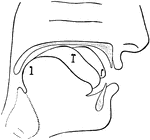Introduction to the Lyon Phonetic Manual
This ClipArt gallery offers 4 illustrations of sign language phonetics, showing an introduction to the topic, as well as how to move the tongue and mouth to make certain sounds.

Code of English Sounds
Chart illustrating 45 hand positions representing sounds in the English language as described in the…

Explanatory Diagram
1) The first or index finger. 2) The second or middle finger. 3) The third finger. 4) The fourth finger.…

Physiological Bases of the Visible Speech Symbols for Consonants
Physiological Bases of the Visible Speech Symbols - Consonants. In representing the consonant a peculiar…

Physiological Bases of the Visible Speech Symbols for Vowels
Physiological Bases of the Visible Speech Symbols - Vowels. In representing the vowel classification…